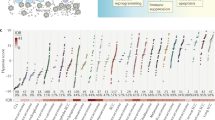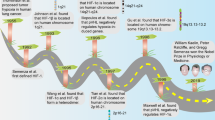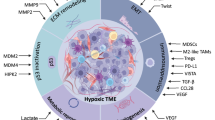Abstract
The aim of this study was to investigate whether tumour hypoxia and/or vascular hot spots promote the development of metastatic disease. The D-12 human melanoma xenograft line was used as a tumour model. Hypoxia and vascular hot spots were detected by immunohistochemistry using pimonidazole as a hypoxia marker and anti-CD31 antibody to visualize endothelial cells. Vascular hot spots were found to be induced in hypoxic foci, owing to hypoxia-induced up-regulation of angiogenesis stimulatory factors. This effect was mediated by interleukin 8 and possibly also by vascular endothelial growth factor. Interleukin 8 positive foci showed a high degree of co-localization with hypoxic foci, as revealed by immunohistochemistry. The incidence of spontaneous pulmonary metastases was associated with the density of hypoxic foci, the density of interleukin 8 positive foci and the density of vascular hot spots in the primary tumour. Treatment with neutralizing antibody against interleukin 8 and/or vascular endothelial growth factor resulted in hypoxia-induced necrosis rather than hypoxia-induced vascular hot spots and inhibited metastasis. Our study suggests a cause-effect relationship between hypoxia and metastasis in cancer and hence an elevated probability of metastatic disease in patients having primary tumours characterized by high densities of hypoxic foci and vascular hot spots.
This is a preview of subscription content, access via your institution
Access options
Subscribe to this journal
Receive 24 print issues and online access
$259.00 per year
only $10.79 per issue
Buy this article
- Purchase on Springer Link
- Instant access to full article PDF
Prices may be subject to local taxes which are calculated during checkout






Similar content being viewed by others
References
Bar-Eli M (1999) Role of interleukin-8 in tumor growth and metastasis of human melanoma. Pathobiology 67: 12–18
Brizel DM, Scully PS, Harrelson JM, Layfield LJ, Bean JM, Prosnitz LR, Dewhirst MW (1996) Tumor oxygenation predicts for the likelihood of distant metastases in human soft tissue sarcoma. Cancer Res 56: 941–943
Danielsen T, Rofstad EK (2000) The constitutive level of vascular endothelial growth factor (VEGF) is more important than hypoxia-induced VEGF up-regulation in the angiogenesis of human melanoma xenografts. Br J Cancer 82: 1528–1534
Ferrara N, Davis-Smyth T (1997) The biology of vascular endothelial growth factor. Endocr Rev 18: 4–25
Fidler IJ, Ellis LM (1994) The implications of angiogenesis for the biology and therapy of cancer metastasis. Cell 79: 185–188
Griffiths L, Dachs GU, Bicknell R, Harris AL, Stratford IJ (1997) The influence of oxygen tension and pH on the expression of platelet-derived endothelial cell growth factor/thymidine phosphorylase in human breast tumor cells grown in vitro and in vivo. Cancer Res 57: 570–572
Hartmann A, Kunz M, Köstlin S, Gillitzer R, Toksoy A, Bröcker E-B, Klein CE (1999) Hypoxia-induced up-regulation of angiogenin in human malignant melanoma. Cancer Res 59: 1578–1583
Horsman MR (1995) Nicotinamide and other benzamide analogs as agents for overcoming hypoxic cell radiation resistance in tumours: a review. Acta Oncol 34: 571–587
Höckel M, Schlenger K, Arai B, Mitze M, Schäffer U, Vaupel P (1996) Association between tumor hypoxia and malignant progression in advanced cancer of the uterine cervix. Cancer Res 56: 4509–4515
Li C-J, Shan S, Huang Q, Braun RD, Lanzen J, Hu K, Lin P, Dewhirst MW (2000) Initial stages of tumor cell-induced angiogenesis: evaluation via skin window chambers in rodent models. J Natl Cancer Inst 92: 143–147
Nowell PC (1986) Mechanisms of tumor progression. Cancer Res 46: 2203–2207
Rofstad EK (1994) Orthotopic human melanoma xenograft model systems for studies of tumour angiogenesis, pathophysiology, treatment sensitivity and metastatic pattern. Br J Cancer 70: 804–812
Rofstad EK (2000) Microenvironment-induced cancer metastasis. Int J Radiat Biol 76: 589–605
Rofstad EK, Danielsen T (1999) Hypoxia-induced metastasis of human melanoma cells: involvement of vascular endothelial growth factor-mediated angiogenesis. Br J Cancer 80: 1697–1707
Rofstad EK, Graff BA (2001) Thrombospondin-1-mediated metastasis suppression by the primary tumor in human melanoma xenografts. J Invest Dermatol 117: 1042–1049
Rofstad EK, Halsør EF (2000) Vascular endothelial growth factor, interleukin-8, platelet-derived endothelial cell growth factor, and basic fibroblast growth factor promote angiogenesis and metastasis in human melanoma xenografts. Cancer Res 60: 4932–4938
Rofstad EK, Måseide K (1999) Radiobiological and immunohistochemical assessment of hypoxia in human melanoma xenografts: acute and chronic hypoxia in individual tumours. Int J Radiat Biol 75: 1377–1393
Rofstad EK, Sundfør K, Lyng H, Tropé CG (2000) Hypoxia-induced treatment failure in advanced squamous cell carcinoma of the uterine cervix is primarily due to hypoxia-induced radiation resistance rather than hypoxia-induced metastasis. Br J Cancer 83: 354–359
Shi Q, Abbruzzese JL, Huang S, Fidler IJ, Xiong Q, Xie K (1999) Constitutive and inducible interleukin 8 expression by hypoxia and acidosis renders human pancreatic cancer cells more tumorigenic and metastatic. Clin Cancer Res 5: 3711–3721
Vaupel P, Kallinowski F, Okunieff P (1989) Blood flow, oxygen and nutrient supply, and metabolic microenvironment of human tumors: a review. Cancer Res 49: 6449–6465
Weidner N (1995) Intratumor microvessel density as a prognostic factor in cancer. Am J Pathol 147: 9–19
Xu L, Xie K, Mukaida N, Matsushima K, Fidler IJ (1999) Hypoxia-induced elevation in interleukin-8 expression by human ovarian carcinoma cells. Cancer Res 59: 5822–5829
Young SD, Marshall RS, Hill RP (1988) Hypoxia induces DNA overreplication and enhances metastatic potential of murine tumor cells. Proc Natl Acad Sci USA 85: 9533–9537
Acknowledgements
We thank Berit Mathiesen, Heidi Rasmussen, Kristin Nilsen and Kanthi Galappathi for excellent technical assistance. Financial support was received from The Norwegian Cancer Society.
Author information
Authors and Affiliations
Corresponding author
Rights and permissions
About this article
Cite this article
Rofstad, E., Halsør, E. Hypoxia-associated spontaneous pulmonary metastasis in human melanoma xenografts: involvement of microvascular hot spots induced in hypoxic foci by interleukin 8. Br J Cancer 86, 301–308 (2002). https://doi.org/10.1038/sj.bjc.6600052
Received:
Revised:
Accepted:
Published:
Issue Date:
DOI: https://doi.org/10.1038/sj.bjc.6600052
Keywords
This article is cited by
-
Can anticancer chemotherapy promote the progression of brain metastases?
Medical Oncology (2018)
-
Stimuli-induced Organ-specific Injury Enhancement of Organotropic Metastasis in a Spatiotemporal Regulation
Pathology & Oncology Research (2014)
-
Circulating proteins as potential biomarkers of sunitinib and interferon-α efficacy in treatment-naïve patients with metastatic renal cell carcinoma
Cancer Chemotherapy and Pharmacology (2014)
-
Antiangiogenic therapy: impact on invasion, disease progression, and metastasis
Nature Reviews Clinical Oncology (2011)
-
Comparative expression pathway analysis of human and canine mammary tumors
BMC Genomics (2009)



